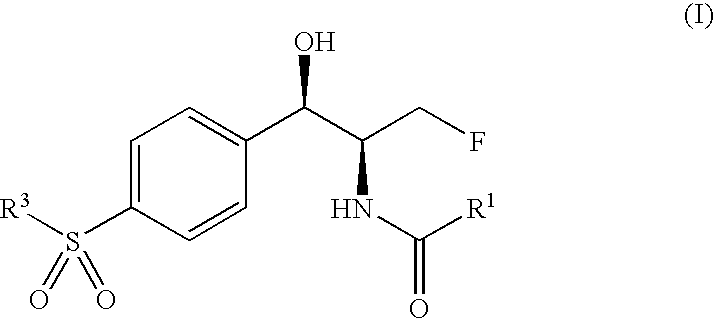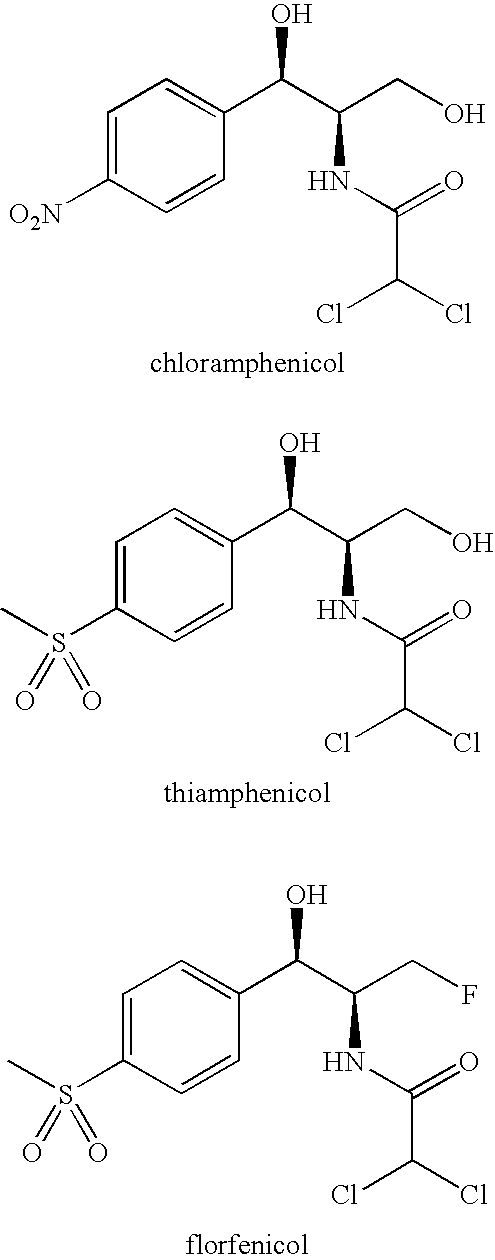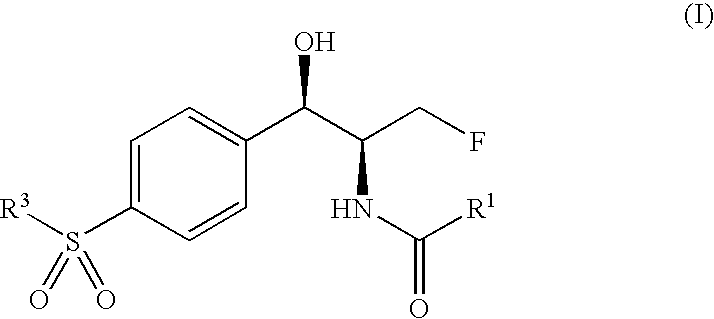Antibacterial 1-(4-mono- and di-halomethylsulphonylphenyl)-2-acylamino-3-fluoroproponals and preparation thereof
a technology of acylamino-3-fluoroproponals and dihalomethylsulphonylphenyl, which is applied in the field of antibacterial 1(4monoand dihalomethylsulphonylphenyl)2acylamino-3-fluoroproponals, to achieve the effect of increasing the resistance of bacteria to chloramphenicol and potent bacterial inhibitory properties
- Summary
- Abstract
- Description
- Claims
- Application Information
AI Technical Summary
Benefits of technology
Problems solved by technology
Method used
Image
Examples
example 1
tert-Butyl-(4S,5R)-4-(fluoromethyl)-2,2-dimethyl-5-(4-methylthiophenyl)-1,3-oxazolidine-3-carboxylate (13)
[0109]N-butyl lithium (n-BuLi), (1.78 g, 28 mmol, 1.2 eq) was added to a solution of tert-butyl (4S,5R)-5-(4-bromophenyl)-4-(fluoromethyl)-2,2-dimethyl-1,3-oxazolidine-3-carboxylate (9.0 g, 23 mmol) in 30 ml of anhydrous tetrahydrofuran (THF) at −78° C. in 30 min, and the reaction mixture was stirred for 30 minutes under N2. 3.1 ml of dimethyldisulfide (1.5 eq) was added, and stirred for 30 min. The reaction mixture was warmed up to room temperature and stirred for 1 hour. A saturated solution of ammonium chloride (50 ml) and ethyl acetate (50 ml) was added and stirred for 30 min. The organic layer was washed with brine (50 ml) and dried over sodium sulfate. After purification, via a column, 8.15 g of white solid of the desired product was obtained.
[0110]1H NMR (400 MHz, CDCl3): σ 1.49 (s, 9H), 1.54 (s, 3H), 1.72 (s, 3H), 2.48 (s, 3H), 3.79 (m, 1H), 4.40 (m, 1H), 5.06 (d, 2H, J=...
example 2
tert-Butyl(4S,5R)-4-(fluoromethyl)-2,2-dimethyl-5-[4-(methylsulfinyl)phenyl]-1,3-oxazolidine-3-carboxylate (14)
[0111]A solution of m-chloroperbenzoic acid (14.3 g, 1.2 eq ) in 100 ml of dichloromethane was added drop wise to the solution of 13 (17.3 g) in 150 ml of dichloromethane at −20° C. The temperature was maintained at −20° C. for an additional 40 minutes. A saturated solution of sodium bicarbonate (80 ml) was added and stirred for 30 minutes. The organic layer was separated and washed with brine (50 ml) and dried over sodium sulfate. After purification (via a column) 13.4 g of the desired product (as a heavy oil) was obtained.
[0112]1H NMR (400 MHz, CDCl3): σ 1.50 (s, 9H), 1.59 (s, 3H), 1.77 (s, 3H), 2.72 (s, 3H), 3.85 (m, 1H), 4.53 (m, 1H), 5.17 (d, 2H, J=8.8 Hz), 7.56 (m, 2H), 7.67 (m, 2H).
example 3
tert-Butyl(4S,5R)-4-(fluoromethyl)-2,2-dimethyl-5-[4-(fluoromethylthio)phenyl]-1,3-oxazolidine-3-carboxylate (15)
[0113]A solution of diethylamino sulfurtrifluoride (DAST), (9.34 g, 1.75 eq ) in 10 ml of dichloromethane was added drop wise to the solution of 14 (12.3 g) and antimony (III) chloride (0.23 g, 0.03 eq ) in 150 ml of dichloromethane (anhydrous) at −5° C., and the reaction mixture was warmed up to room temperature overnight. A cold saturated solution of sodium bicarbonate (80 ml) was added and stirred for 30 min and extracted with dichloromethane (100 ml×2). The organic layer was washed with a 10% solution of sodium bicarbonate and with brine (50 ml) and dried over sodium sulfate. After purification, via a column, 10.7 g of the desired product (as a heavy oil) was obtained.
[0114]1H NMR (400 MHz, CDCl3): σ 1.50 (s, 9H), 1.58 (s, 3H), 1.70 (s, 3H), 3.81 (m, 1H), 4.49 (m, 1H), 5.10 (d, 2H, J=7.2 Hz), 5.70 (d, 2H, J=52.8 Hz), 7.41 (m, 2H), 7.52 (m, 2H).
PUM
| Property | Measurement | Unit |
|---|---|---|
| temperature | aaaaa | aaaaa |
| temperature | aaaaa | aaaaa |
| temperature | aaaaa | aaaaa |
Abstract
Description
Claims
Application Information
 Login to View More
Login to View More - R&D
- Intellectual Property
- Life Sciences
- Materials
- Tech Scout
- Unparalleled Data Quality
- Higher Quality Content
- 60% Fewer Hallucinations
Browse by: Latest US Patents, China's latest patents, Technical Efficacy Thesaurus, Application Domain, Technology Topic, Popular Technical Reports.
© 2025 PatSnap. All rights reserved.Legal|Privacy policy|Modern Slavery Act Transparency Statement|Sitemap|About US| Contact US: help@patsnap.com



